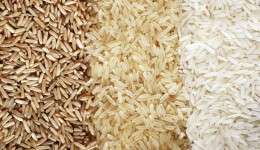Different Types Of Rice in India
- By: Admin

Rice is an important element of many people's diets particularly in India for a variety of reasons. The primary reason is that rice is highly filling in nature and gives energy to the body. Aside from that, rice is nutritious and high in minerals, meeting the body's daily requirements. Are you ready to experience the aroma and flavor of several rice varieties? Let's have a look at them!
Brown rice
Brown rice has a slight nutty flavor that provides a nice flavour to any brown rice recipe. Brown rice is preferred by many health-conscious people over other types of rice because it is low in calories and high in vitamins and minerals. It's a full grain meal that's also light to consume!
Basmati rice
Basmati rice is a famous variety of rice in India and throughout Asia. This delicious rice is used in a variety of Indian and Asian cuisines to produce interesting and unique dishes. This rice pairs well with fresh herbs and green onions, as well as typical Indian side dishes. It is available in white and whole-grain varieties and may be found at any grocery shop.
Katarni rice
Katarni is a Ceremonial Rice produced in Bihar and is recognized for its lovely smell, local taste, and great cooking quality.
Non Basmati rice
Rice that isn't basmati comes in a variety of forms and sizes. Some are long and thin, while others are short and thick, shaped like beads, or spherical. None of them compare to basmati rice in terms of features.
Organic Rice
Organic rice is growing increasingly popular as the world's population recognizes the value of eating healthy foods and preserving the environment. The rice crop produced as a consequence of using bio-fertilizers and other organic nutrition sources is healthier and more nutritious for the customer. Whole grain organic brown rice is low in calories and high in beneficial elements including fiber, phytochemicals, and vital minerals.
Organically grown produce has lower detectable levels of pesticide residue than conventionally grown produce. The produce may have residue due to pesticides approved for organic farming or because of airborne pesticides from conventional farms.
Organic foods have the same quantity of nutrients, vitamins, and minerals as non-organic meals. Organic foods usually contain fewer pesticides, fewer multidrug-resistant microorganisms, and no GMOs or foods.
Unfortunately, natural does not always imply organic, and there are no assurances. The organic food industry is the most tightly controlled. Only organic ensures that no hazardous synthetic pesticides, poisonous synthetic herbicides, or chemical NPK fertilisers are used in manufacturing, and that animals are not given antibiotics or growth hormones.
Organic products are more expensive than conventional ones.... In comparison to demand, organic food supply is restricted. Organic food production costs are often higher due to higher labour input and farmers' inability to produce enough of a particular product to minimise the overall cost.



